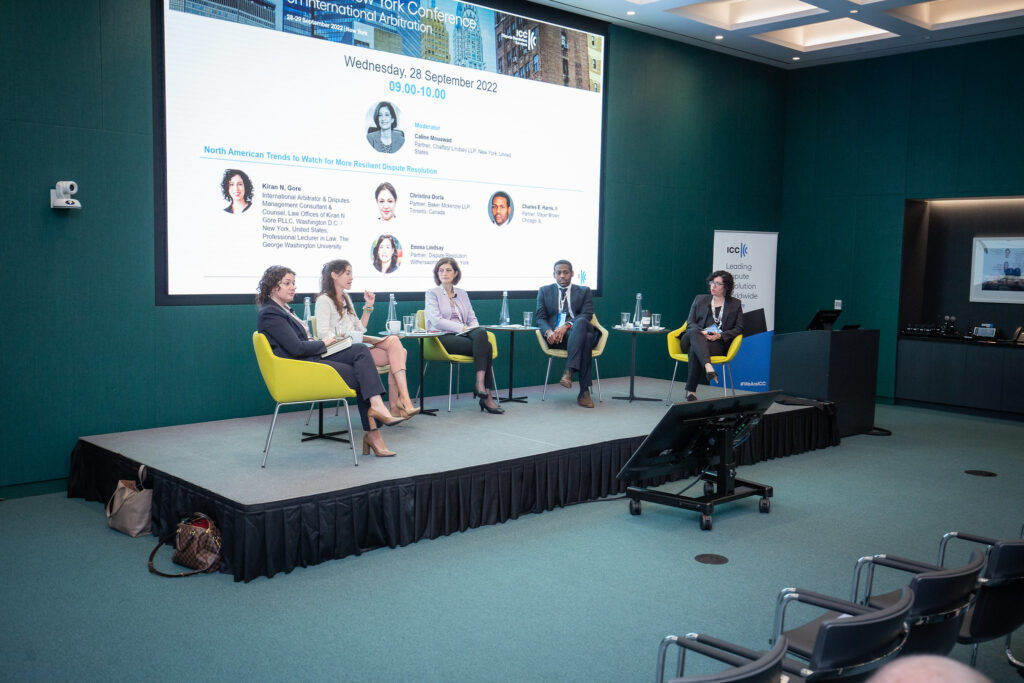The theme of this year’s sold out 17th ICC New York Conference on International Arbitration was “Building Resilience”, and resilience was on full display as the North America arbitration community arrived at the offices of conference host Hogan Lovells on Madison Avenue, the first fully in-person ICC New York conference since the pandemic. Oliver “Ollie” J. Armas (Hogan Lovells LLP) put it best when, in welcoming attendees, he expressed how invigorating it was to be back in a room full of friends and colleagues.
North America Trends to Watch for More Resilient Dispute Resolution
The day began with a lightning discussion round on North American trends to watch for more resilient dispute resolution. Moderated by Caline Mouawad (Chaffetz Lindsey LLP), the panel explored legislative and case developments, considering how they might improve—or hinder—the post-pandemic arbitration and dispute resolution landscapes. Charles E. Harris, II (Mayer Brown) began with the observation that virtual hearings are here to stay. Noting that institutions like ICC were very nimble in adapting to virtual hearings throughout COVID-19, Harris was of the view that virtual hearings do not materially change the manner in which evidence is delivered or received and can enhance efficiency of the process. Alert to client preferences, however, Harris has noticed a trend where some clients strongly prefer in-person hearings and wish to know up front the attitudes of arbitrators towards in-person versus remote hearings.
Building on this theme, Christina Doria (Baker McKenzie LLP) noted that courts were similarly called upon to modernize processes in light of the pandemic, and remembered as now passé the concerns of April 2020, such as “Should we adjourn the hearing?”, “What about the ICC Rules?”, “Is there a right to a physical hearing?”. A particular innovation in Canadian courts has been the advent of “case management arbitration”, whereby court backlogs have been reduced through the referral to arbitration of an aspect – typically something procedural or interlocutory – of a larger commercial dispute. Emma Lindsay (Withersworldwide) added that UK courts encouraged parties to consider arbitration as a way to reduce unwieldy caseloads during the pandemic.
Pulling these strands together, Kiran Nasir Gore (Associate Editor) observed that arbitration is able to respond to changed circumstances with speed and agility, reflecting the resilience of the arbitral model. The ability to choose arbitrators that are conversant with technology, and the creativity that arbitration affords to different stakeholders (counsel, arbitrator, institution) makes arbitration reliable and innovative in challenging times.
Turning to the collision of arbitration and insolvency (explored in the Blog here and here), Gore stated that the two most interesting issues are capacity (does the party entering into insolvency have capacity-related challenges?) and enforceability (in the US, under Chapter 11, there is an automatic stay provision, which would appear to include the staying of arbitral proceedings). For Doria, these issues are front and center in Canada, with courts needing to figure out how to balance the twin objectives of even distribution of assets to creditors (including those seeking to enforce arbitral awards) and the rehabilitation of the company.
Petrowest Corp. v. Peace River Hydro Partners illustrates the point. An appointed receiver – also acting as bankruptcy trustee – brought a single suit in court to recover payments owed under several contracts, each of which contained an arbitration agreement. Can a receiver opt out or disclaim an arbitration clause? The British Columbia Court of Appeal held that it can under the doctrine of separability. The arbitration bar ‘went berserk’ – separability is to be used as a shield to preserve arbitral jurisdiction, not as a sword! Perhaps the bigger question is: how will the Canadian Supreme Court resolve the competing policy concerns of arbitration and insolvency, both of which are founded on notions of efficiency? Watch this space.
Another topic on the panel’s agenda was the vexed issue of discovery in the wake of ZF Automotive US, Inc. v. Luxshare, Ltd. (discussed by Dana MacGrath (MacGrath Arbitration) here). Harris noted that there are broadly three options for parties seeking discovery to explore. First, and perhaps easiest, is the ‘interested party’ option under 28 USC § 1782(a). A second option is through the issuance by the tribunal to the relevant court of letters rogatory. Third, as was seen in Jones Day v. Orrick, is the 9th Circuit holding that the NY Convention – through 9 USC §7 – can be used not only to enforce awards, but also to enforce arbitral subpoenas from international arbitrations.
To round out the discussion on resilience, Lindsay posed a number of open questions as to the impact of sanctions on the field of international arbitration. The raft of unilateral sanctions imposed over recent years has created frictions that impact all stakeholders, from arbitrators to counsel, institutions, and of course the parties themselves. Counsel may face difficulty screening potential clients; institutions may encounter challenges in the acceptance of payments; banks may be reluctant to facilitate payments – whether from sanctioned or non-sanctioned entities. Such frictions will undoubtedly add to the costs of arbitration.
Sanctions also increase the risk of failure to perform contractual obligations, resulting in the invocation by respondents of doctrines such as impossibility of performance, frustration or force majeure to excuse or justify an inability to perform. Though we are yet to see a case of this kind in investor-state arbitration, unilateral sanctions imposed by a State could theoretically cause harm to an investor, giving rise to a claim that the impact of sanctions constituted an expropriation or breach of a fair and equitable treatment clause.
Sanctions may also limit the available pool of arbitrators and counsel, inhibiting party choice and diversity. If arbitrators are reluctant to take on cases that involve targeted entities, institutions may avoid the additional cost and time burden of proposing nationals of sanctioning States. In sum, sanctions create frictions that impact all stakeholders, may potentially be generative of disputes, and challenge the resilience of international arbitration as a guarantor of access to justice.

A Digitally-Enabled ICC
ICC International Court of Arbitration Secretary General Alexander G. Fessas illustrated the many advances made by ICC Dispute Resolution Services in ensuring unmatched quality of service that lives up to the ICC mission to “make business work for everyone, every day, everywhere.” Fessas announced that in mid-October, ICC will launch “ICC Case Connect”, a brand new, secure case management platform that will enable easy communication between all stakeholders. Parties will be able to file requests for arbitration online; upload and search documents in a secure dedicated space; and access the platform from anywhere, at any time, on any device. Informed by a philosophy of “case management made easy,” Fessas stressed the immediate benefits of ICC Case Connect for all: “No more oversized email attachments. No more delivery issues. No more repetitive tasks. A win-win-win for parties, arbitrators, and the institution.”
The ICC has also recently overhauled its ICC Dispute Resolution Library platform to make more commentaries, awards, and other ICC materials readily available. Claudia Salomon, President of the ICC International Court of Arbitration, previewed the importance of this development in her recent conversation on Kluwer’s International Law Talk podcast.
Fireside Chat on Business Trends
Next up was a fireside chat with Claudia Salomon and Nadia Tuma-Weldon, EVP and Global Head of Thought Leadership at McCann WorldGroup. In a wide-ranging discussion that challenged common business tropes surrounding issues of diversity, Gen Z demographics and stereotypes, Salomon and Tuma-Weldon considered some of the real trends shaping global business.
From the advertising world perspective, Tuma-Weldon expressed that she feels “allergic” to the term “consumer,” preferring to take a macro view of a person’s life, and use a broad, bird’s eye view of culture to find unseen opportunities and meet people where they are. Salomon is similarly “allergic” to the concept of “users” of dispute resolution services, rejecting the connotation the term brings of using and discarding rather than forming enduring relationships with ICC.
This entrée dovetailed into a deeper conversation about how to think about crises. Is it crass for businesses to be thinking about crises as opportunity, or is there a way for businesses to think about growth without exploitation? For Tuma-Weldon, the answer lies in providing products or services that are additive to people’s lives and that address real rather than manufactured needs. A related concept for the audience is “cultural nuance” or, as Tuma-Weldon put it, “where are cultures on the crisis journey?”
More coverage of the 17th ICC New York Conference on International Arbitration is available in Part 2.
________________________
To make sure you do not miss out on regular updates from the Kluwer Arbitration Blog, please subscribe here. To submit a proposal for a blog post, please consult our Editorial Guidelines.


